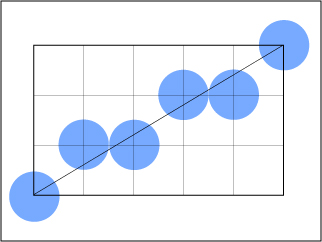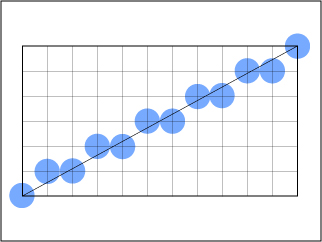1.4.1. Staircase Effects
As described in the chapter line
rasterisation, a line represented in raster mode has to be
approximated by a sequence of pixels.
"Consider using the midpoint algorithm to draw
a 1-pixel-thick black line, with slope between 0 and 1, on a white
background. In each column through which the line passes, the algorithm sets
the colour of the pixel that is closest to the line. Each time the line
moves between columns in which the pixels closest to the line are not in the
same row, there is a sharp jag in the line drawn into the canvas. The same
is true for other scan-converted primitives that can assign only one of two
intensity values to pixels." (FOLEY et al. 1996, p. 132)

If we now use a display device with a higher horizontal and vertical resolution, the jags are getting smaller but more numerous:

Although the resulting picture looks better, jags are still existing and
in addition the memory requirement of the picture increases. Increasing
resolution is an expensive solution that only diminishes the problem of jaggies,
but it does not eliminate the problem itself.
We
therefore will explain you in the next chapter a technique called anti-aliasing
that results in better images without shooting up its memory
requirements.
